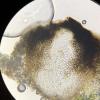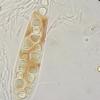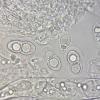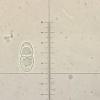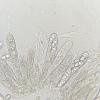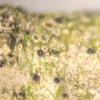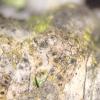
22-12-2025 23:38
Patrice TANCHAUDBonsoir, récolte sur un mur en pierre, apothéci

21-12-2025 09:32
Hello.A tiny ascomycete found embedded in wood in

22-12-2025 00:47
Patrice TANCHAUDBonsoir, récolte à proximité du milieu dunaire

21-12-2025 21:32
Pol DebaenstHello, Garden, Burgweg 19, Veurne, BelgiumOn 10/1

21-12-2025 21:40
Isabelle CharissouBonjour, j'aimerais connaitre les références de

21-12-2025 21:31
Pol DebaenstHello, Garden, Burgweg 19, Veurne, BelgiumOn 10/1

21-12-2025 21:31
Pol DebaenstHello, Garden, Burgweg 19, Veurne, BelgiumOn 10/1

20-12-2025 23:08
Patrice TANCHAUDBonsoir, récolte sur sol sablonneux dans l'arri�
 Hi
HiFound on fallen ulmus twigs. Dont know if its lichenicolous or if it grows on ulmus. But it seams that it will appear were lecanora is present. Ebr />Spores 26-30x 12-14um with epispor 4-5 um wide old Spores verrucose light brown.
Asci 125-145x 15-17 um
Asci lugol negative K+I negative
Asci 8 spored
Parafyses septate
Involucrellum react K+green
Anyone have seen anything like it or knows genus?
i have tryed some keys with no match.
All the best,
Robin
Hallo Robin,
to me (as a lichenologist) the ascomata look like to belong to a saprophytic fungus
the lichen seems to be (almost) dead overgrown in some parts by colonies of epiphytic green (non-symbiotic) algae
what suggests the branch (and the lichen) is dead for relatively long period
lichenicoles are also usually much smaller
I must say that I am not the expert at all but tried to pass through some literature and older discussion on this forum
one of the candidates could be Dothidotthia ramulicola ?
discussed on the forum 6 years ago: see: "
http://www.ascofrance.com/forum/26773/didymosphaeria
the discussed specimen is at least seemingly slightly similar to yours, which could be immature? as noted in the discussion by Walter Jaklitsch for this taxon?
but maybe I am completely wrong, better to ask an expert on bitunicate pyrenomycetes
according to the description in the monograph by Barr (1989) in Mycotaxon this species should form gregarious ascomata on a stroma
perhaps the mentioned taxon is a dustbin name ?
all the best
Zdenek

Thank you for the replay and your effort to find a candidtae.
As you say we could exclude lichenicoles, I will ask Walter to se if it is the species you named but as it seams it is only pertecia one by one and no gregarious ascomata on a stroma but i will cut and look closer on material when i home.
All the best,
Robin

